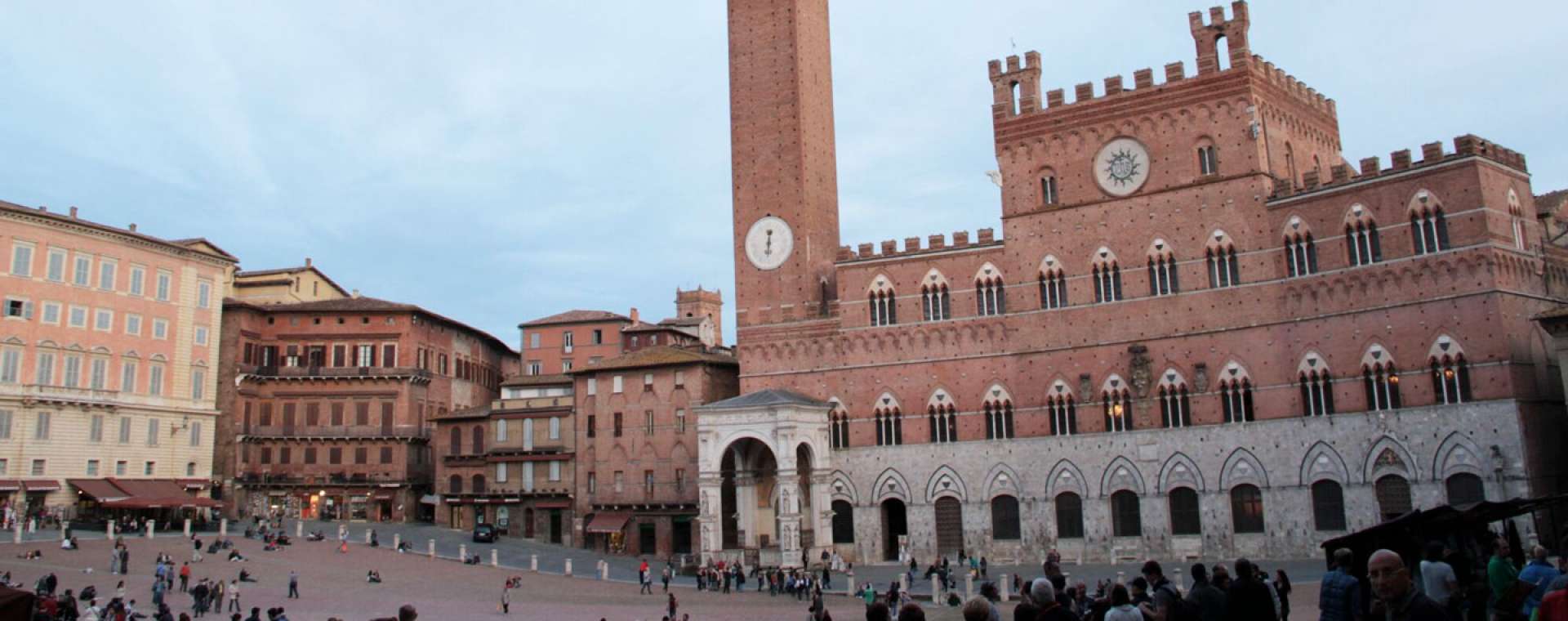Piazza del Campo — “Il Campo” — is reputedly one of Italy’s most beautiful squares. If anything, that’s an understatement. Whatever you’ve heard, or the photos you’ve seen, nothing prepares you for the first time you squeeze down one of its stepped stone entrances and just stare.
The scallop-shaped design in herringbone red brick was laid out in the 1320s, at the peak of Siena’s wealth and power. It’s divided into 9 sections in honour of the Nove (“the Nine”), a republican government who ruled Siena from the 1280s to the 1350s. The Nine were charged with ruling in the “common good”, not in favour of the nobility.
At any time of day, students, schoolchildren, picnickers and regular Sienese relax as vast shadows shift slowly across the paving stones. Red brick above and below makes the whole square glow a rich burnt-sienna.
A historic city hall
Piazza del Campo has been the heart of Sienese civic life for almost a millennium, and along with the cathedral square, has the city’s key sights. If you’re staying in one of our villas near Siena over July 2 or August 16, you’ll find the Palio completely takes over the square. This historic bareback horse race is part of what makes the Campo more than just a “sight”; it’s the fabric of a fiercely independent city.
Towering over the Campo, the Palazzo Pubblico is Siena’s city hall, complete with crenellations and Gothic mullioned windows. At the height of Sienese power, many officials were not allowed to leave this vast palace during their 6-month term of office, to make sure they could not be corrupted by “outside forces”.
On the far-left as you face the palace facade is the Cappella di Piazza, erected in thanks for delivering the city from the ravages of the 1348 Black Death. This calamitous plague killed two-thirds of Siena’s residents, including an entire generation of artists who had few contemporary rivals anywhere in Italy.
The palace’s grandest rooms are preserved as Siena’s Museo Civico, and include wall paintings that are the most important secular frescoes of the Middle Ages. In 1338–39, local artist Ambrogio Lorenzetti painted his allegories of “Good Government” and “Bad Government”, which graphically show how virtues and vices flow from the republic’s decisions. The Nine met in this very room; Lorenzetti’s frescoes were a not-so-gentle reminder of their job.
Elsewhere in this extraordinary palace are chambers and chapels decorated by Sienese painters Simone Martini, Taddeo di Bartolo, Domenico Beccafumi and others.
The Torre del Mangia was built separately. If you have a head for heights — and are definitely not claustrophobic — you can summit on a separate ticket.
Unchanged since the Middle Ages
Eighty-seven metres below, at the apex of the Campo’s shell, is the Fonte Gaia, a major water source from the 1300s and decorated in 1419 with a fountain by sculptor Jacopo Della Quercia. The version in the Campo is a copy from the 1850s. The original panels with a mix of Biblical and Roman mythological figures are on show inside the former city hospital — now Santa Maria della Scala museum — opposite Siena’s cathedral.
Strictly speaking it’s not on the Campo but around the back, the Archivo di Stato is Siena’s archive, with records dating back to the 1200s. On weekday mornings you can take an accompanied tour of its gallery for the Tavolette di Biccherna.
These are the hand-painted covers to the city’s annual accounts, for which big-name local artists (Ambrogio Lorenzetti, Matteo di Giovanni and others) were commissioned between 1257 and the early 1700s. Their subject was often a scene from everyday life — a magistrate passing judgement, the city treasurer washing his hands or even (in 1467) tents pitched outside the walls after a massive earthquake shook Siena.
Also nearby, behind the Palazzo Pubblico, Piazza del Mercato is Siena’s old market square, where deli Gino Cacino di Angelo is a fine place to buy a sandwich loaded with Tuscan produce. Take it back up to the Campo — where else? — to eat.
